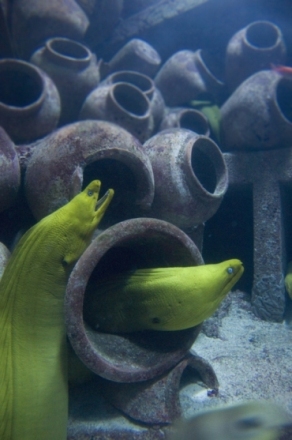|
Loading
That's a Moray Eel!There are at least 80 species of eel worldwide, with the incredible Green Moray Eel being the largest of them all. The Green Moray Eel, Gymnothorax funebris, has a maximum length of 8ft (2.4m) and can weigh up to 65lbs (29.5kg).
In contrast to what the name suggests, this Green Eel is actually brown and simply appears green due to a thick layer of yellow mucus which covers its long muscular body. The body of the eel is laterally compressed and has continuous dorsal and anal fins with a short tail. They do not have any scales and are also lacking pelvic and pectoral fins. They do however have very large slender heads with conspicuous tube-like nostrils and extremely sharp teeth. They are ‘sit and wait’ predators so will spend most of their time hanging out of a rock or cave with about 85% of the eel hidden inside waiting for something tasty to pass by. They have also developed the ability to tie itself in knots to enable it to be able to tear food more effectively. Morays are also nocturnal hunters so will generally free-swim during the night weaving in and out of holes in the rock looking for crustaceans, squid, octopus and other small fish. On rare occasions you may find this Eel free-swimming during the day, which is an amazing but potentially scary sight due to their large size and respiration style. The Moray opens and closes its mouth continuously to allow a steady flow of water to pass over its gills and out through a hole in the back of its head. Due to the fact that all of the eel’s sharp teeth are exposed, most people associate this with threatening behavior and therefore give them a very bad reputation. In actual fact, the Moray only becomes aggressive when attacked, provoked or intimidated. This eel has very few natural predators, but is frequently killed by humans who fear them simply because of their reputation. This is really not necessary as long as you keep your distance then we can both live together harmoniously. Even though the eel is quite common and not yet endangered, extra care should still be taken to ensure its survival. As a top predator, they help to keep fish and crustacean populations low enough to prevent overgrazing and therefore allow valuable coral growth. Therefore, they are of significant ecological importance. ‘And that’s a Moray’. - By Laura H. Back to Caribbean Scuba Diving Home Page from Moray Eel
|





 These large, gnarly looking beasts can be found between the depths of 2m and 30m, but have occasionally been observed at up to 50m. While scuba diving in the Caribbean you will generally see them inhabit rocks and caves on shorelines, reef and in the mangroves. Although a predominantly marine creature, the Moray actually has the ability to stay out of water for around 4 hours and has even been spotted traveling overland!Moray Eels are relatively solitary animals, which is mostly due to their feeding technique.
These large, gnarly looking beasts can be found between the depths of 2m and 30m, but have occasionally been observed at up to 50m. While scuba diving in the Caribbean you will generally see them inhabit rocks and caves on shorelines, reef and in the mangroves. Although a predominantly marine creature, the Moray actually has the ability to stay out of water for around 4 hours and has even been spotted traveling overland!Moray Eels are relatively solitary animals, which is mostly due to their feeding technique. 

